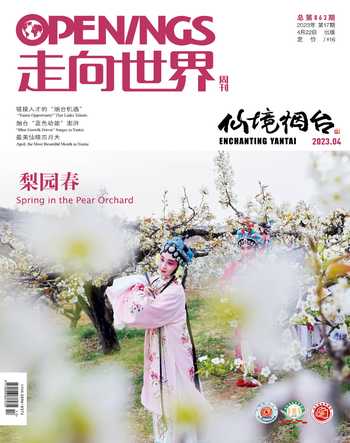发芽葱
孙为刚

冰雪消融,春草绽绿。初春,一种沾着泥土、带着枯叶、露出嫩芽的葱悄然上市,这便是家乡的发芽葱。
发芽葱是大葱的一种。大葱乃山东特产,由根、叶、茎组成,其主要部分俗称葱白,学名假茎。发芽葱因其在嫩芽初发时即出土上市,故得名。
发芽葱与其他大葱的不同之处在于,它不是春天栽种,秋天收获,而是秋天栽培,春天出土。冬天来临时,乡亲们将垄背培土,将葱白深埋。在北方漫长的冬天里,发芽葱在大地的怀抱里享受雪水的滋润,吸取泥土的濡养,这让它从形状到口味都显得与众不同。发芽葱的叶片尖而厚,葱白润而白,味道鲜又嫰。发芽葱是时令蔬菜,图的是个新鲜,待到嫩芽长成了绿叶,葱白不再细嫰脆生,便不叫发芽葱了。因此,每年冬天刚过,新春初临,娇嫩的葱芽刚刚钻出地面,菜农们便迫不及待地将发芽葱从地里挖出来。带着地里的土渣子,顶着冬天的干叶子,发芽葱就这样不修边幅地上市了。莫怪发芽葱的自暴自弃,也别怨农家的匆忙大意,发芽葱要的就是抢个先、图个鲜、卖个好价钱。
众所周知,葱除了调味和入肴,还可生吃。山东人乃至整个北方人,尤以生食为佳。《中国实业志》载:“葱,鲁人多生食。”在生吃的大葱中,发芽葱是首选品种。
生吃大葱,山东有两种吃法最为著名:一是煎饼卷大葱,二是大葱蘸酱。无论哪种吃法,发芽葱都是生吃大葱的首选,都是山东人的最爱。剥去干枯的叶子,露出嫩绿的葱芽和象牙般的葱白,此时的大葱经历了一个冬天的冰封雪冻,已经滤去了辛辣,只留下微甜,蘸上大酱,美美地咬上一口,甜丝丝,脆生生,断茬处流出乳白色的汁液,一个字:“美!”两个字:“特美!”在我的老家,将吃发芽葱称作“咬春”。你听听,多生动的字眼,乡亲们感受春天,竟然是从这不起眼的发芽葱开始的。
可能是越冬的需要,与普通大葱相比,发芽葱的线状根须特别发达,细密绵长。记得小时候,姥姥在我家主政,本应扔掉的发芽葱根,她老人家也不舍得丢弃,而是洗净切碎,打上個鸡蛋,或是放上勺虾酱,搅一搅,熥咸菜吃,那味道至今令人回味。我想,姥姥的做法,或许不仅仅是为了节俭,更是出于对发芽葱的一种挚爱。
毋庸讳言,因为大葱含有挥发性硫化物,尤其生吃,会产生不好的气味,历来为文明人所诟病。但是,这些弊端挡不住山东人对发芽葱的挚爱,人们在想法去除口中异味的同时,依然照吃不误。我想,不是爱到极致,不会如此执着。
大葱是四季蔬菜,即使没有塑料大棚,一年四季人们都会见到大葱的踪影。但是,发芽葱不同,每年上市的时间很短,真的是“过了这个村,就没有这个店了”。对于喜欢发芽葱的山东人来说,若是错过了时机,就会后悔一年。今天,随着塑料大棚的普及,发芽葱也走进了大棚,成了温室里的宠儿。虽然也在初春上市,但是,大棚里的发芽葱没有经历风雪的折磨,模样儿虽然比露天地里生长的发芽葱干净水灵,但是口味、营养就实在不敢恭维了。
啊,家乡的发芽葱,无论我走到哪里,每到春天,我就会想起那甜丝丝、脆生生的发芽葱。
Sprouting scallions are a special type of scallions, a local vegetable in Shandong. They consist of roots, leaves and stems, among which the stems, with a scientific name of cauloid or popularly known as scallion stalks, are a major part of scallions. They get its name because with the coming of spring these scallions buried in the soil will sprout and are sold on the markets.
Unlike other types of scallions which are usually planted in spring and harvested in autumn, sprouting scallions are cultivated in autumn and reaped in spring. When winter comes, farmers bury the scallion stalks deeply by adding more soil over them. In the long winter of northern China, they enjoy the moisture of snow water and absorb the nourishment of soil, which makes them unique in both shape and taste. With pointed and thick leaves and white and smooth stalks, sprouting scallions taste fresh and tender. Sprouting scallions are seasonal vegetables and they cannot be thus called as soon as the tender sprouts grow into leaves when the delicate and crispy taste disappears. Therefore, every year in the early spring when the tender sprouts grow out of ground, the sprouting scallions are dug out by vegetable farmers and brought to the market still with soil residue or dry winter leaves. Of course, the untidy appearance of sprouting scallions is not the fault of the scallions themselves or the vegetable farmers. The most important things about sprouting scallions are timeliness, freshness, and good prices.

